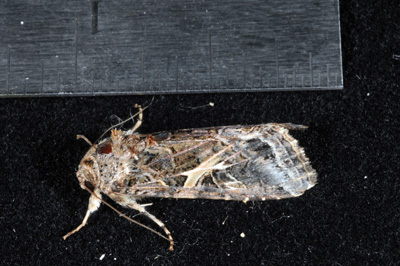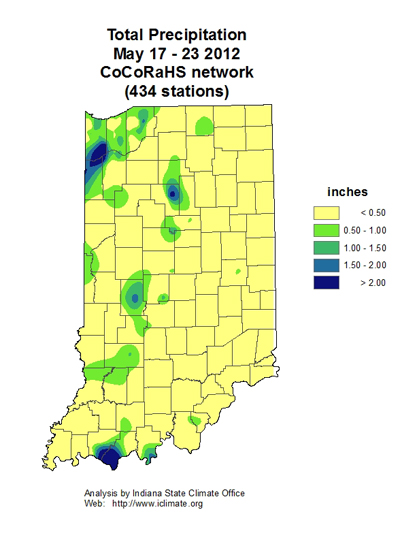Pest & Crop Newsletter, Entomology Extension, Purdue University
Mishmash of Insect Pest Reports – (John Obermeyer and Christian Krupke)
• This season’s bizarre weather = interesting insect happenings!
• Potato leafhopper, cereal leaf beetle, and yellowstriped armyworm are found in uncommonly high numbers this year.
You may have noticed large numbers of potato leafhoppers around your lights at night recently. Generally, we are reporting the arrival of potato leafhopper into the state about this time, but not potentially economic numbers. This year the numbers are much higher than usual, likely because the dry, warm weather is pushing these populations – dry, hot weather and the stressed plants that come with them favor this pest. Pest managers are encouraged to inspect new growth soon after cutting for potato leafhopper, this is when the alfalfa is most susceptible to feeding leading to reduced yields and protein levels. Remember, once yellowing or “hopper burn” is seen, the damage is already done!
Three cereal leaf beetle larvae and damaged wheat leaves (sample provided by Gary Battles)
Gary Battles, of St. Joseph County reported an economic infestation of cereal leaf beetle in wheat. Small instar larvae, are feeding on wheat foliage, most importantly the flag leaf. The “stripping” of green tissue was severe enough that the field appeared frosted from the road. Other pest managers have reported higher than normal levels of this pest. Occasionally we’ll hear of reports in Ohio that cereal leaf beetle numbers are reaching just below or at economic levels (i.e., average of 1 or more adults/larvae per plant), but this is a first in a long time that I’m aware of in Indiana.
Closer view of two cereal leaf beetle larvae and damage to wheat leaf (sample provided by Gary Battles)
Steve Dlugosz, Harvestland Co-op, reports isolated infestations of yellowstriped armyworm in 3-5 leaf corn in east central Indiana counties. Though the damage is spotty throughout many fields, some areas are being defoliated significantly. Most of the worms are around ½ inch long, indicating they will be feeding for many more days. Just as with the “true” armyworm’s cousin, the yellowstriped removes chunks of plant tissue and may sometimes be seen on the foliage during the day. The fields being damaged are conventionally tilled, which doesn’t help us understand the high numbers in those fields. Yellowstriped armyworm are generally an oddity found in low numbers and spotty, feeding on many different crops. For treatment decisions, follow the armyworm threshold, over 50% of the plants being freshly fed on with larvae less than 1-1/4 inch long.
Yellowstriped armyworm feeding on tomato foliage
Yellowstriped armyworm moth
Please keep reporting to us, as this looks to be a very interesting year…fasten your seat belts. Happy Scouting!
.
![]()
Click here for the Blacklight Trap Catch Report
![]()
VIDEO: Corn Seedling Blights and Proper Plant Sampling – (Kiersten Wise and Gail Ruhl)
Cornfields, especially those planted in mid-April, throughout Indiana are exhibiting symptoms of seedling blights. In this video, we discuss the symptoms and causes of seedling blights in corn, and demonstrate how to sample fields to determine if seedling blights may be to blame for uneven stands. For more information, please reference last week’s article, “Seedling blights observed in Indiana cornfields” which can be accessed at the following link: <http://extension.entm.purdue.edu/pestcrop/2012/issue8/index.html#seedling>.
Samples, for accurate diagnosis, should be sent to the Purdue Plant & Pest Diagnostic Laboratory. Specific information on submitting/shipping samples, and downloading a submission form, can be found at: <http://www.ppdl.purdue.edu/PPDL/physical.html>.
Hot & Dry: Toll on Young Corn? – (Bob Nielsen) -
Some of the local curmudgeons who gather every morning at the Chat ‘n Chew Cafe over rolls and coffee have been raising questions about whether this year’s record-setting early planted corn crop is as healthy as the government says it is. In addition to the spate of reports about seedling blight and replanting occurring throughout the state (Wise, 2012), they worry about the possible effects of recent and pending hot and dry spells on the health of the young corn crop.
While it is true that a field of young corn technically does not use a lot of water on a per acre basis every day, it nevertheless requires adequate soil moisture to support the initial development of the young plants’ nodal (permanent) root systems in the early leaf stages of stand establishment. The success or failure of the initial development of a corn plant’s nodal root system greatly influences the success or failure of the young corn plant in transitioning from “life support” using kernel reserves to relying on the developing nodal root system for “life support” (Nielsen, 2010a). This important transition period begins around the V3 stage of development (three visible leaf collars).
Corn younger than V3, still relying on its kernel reserves, can look pretty darn good and uniform. However, if severe stresses limit the development of the first few nodal sets of permanent roots, then the plants will struggle or fail to complete the transition from reliance on kernel reserves to reliance on nodal roots. Examples of severe stress that can limit this initial root development include seedling disease, repeated defoliation events (e.g., frost, sand-blasting), shallow soil compaction, corn rootworm injury, corn nematode injury, excessively wet surface soils, excessively dry surface soils, excessively cold surface soils, and excessively hot surface soils. Consequently, fields that were pleasing to the eye last week can turn ugly almost overnight if it struggles through the important transition period.
Side note: Severe stresses that injure the seed or mesocotyl prior to a successful transition to the nodal root “life support system” will kill or severely stunt a corn plant. The reason that seedling blight has been so devastating in recent weeks is the fact that the crop was young enough that it had not yet transitioned to full nodal root support and, thus, was vulnerable to damage to the mesocotyl or seed.
The concern raised by the locals over at the corner table about the recent unusually warm temperatures and the forecast of more of the same is a valid one given the current stage of development of much of the state’s corn crop. Approximately 76% of the state’s corn crop is currently at leaf stage V5 or younger (my estimate). Maybe a third or more is V3 or younger (my estimate).
Concerns over hot AND dry weather right now are similarly valid given that many fields have not yet successfully developed their initial set of nodal roots. Excessively hot and, more importantly, dry surface soils during this transition period can literally desiccate root tips and stop further elongation of young roots. Such stress over an extended time period can ultimately kill young corn plants (i.e., fatal drought stress) or result in the appearance of the “rootless” or “floppy” corn syndrome as the corn plants develop further (Nielsen, 2010b).
Side note: The good news about a drier than normal April and May is that dry soils warm more quickly than do wet soils. In fields where the moisture deficit is not critical, the drier and warmer soils this spring have likely been conducive to deeper initial root development by the corn plants. Such deeper root development may pay dividends if the dry conditions turn into a true drought.
The bottom line is that excessively warm weather, especially where soils are or will soon be excessively dry, may indeed take a toll on the health and yield potential of young corn if the development of its permanant (nodal) root system has been compromised. Root development also compromised by shallow soil compaction, corn nematodes, anhydrous ammonia or starter fertilizer injury, or other severe below-ground stresses will only compound the continued stress due to excessive heat and dry soils.
Pray for rain or turn on the irrigation.
Related Reading
Nielsen, RL (Bob). 2010a. Root Development in Young Corn. Corny News Network, Purdue Univ. <http://www.kingcorn.org/news/timeless/Roots.html> [URL accessed May 2012].
Nielsen, RL (Bob). 2010b. “Rootless” or “Floppy” Corn Syndrome. Corny News Network, Purdue Univ. <http://www.kingcorn.org/news/timeless/FloppyCorn.html> [URL accessed May 2012].
Robertson, Alison & Gary Munkvold. 2012. Seedling Diseases Reported in Corn and Soybean. Integrated Crop Management Newsletter. Iowa State Univ. <http://www.extension.iastate.edu/CropNews/2012/0516robertson.htm> [URL accessed May 2012].
Wise, Kiersten. 2012. Seedling Blights Observed in Indiana Cornfields. Pest & Crop Newsletter, Purdue Univ. <http://extension.entm.purdue.edu/pestcrop/2012/issue8/index.html> [URL accessed May 2012].
![]()







